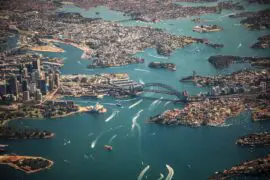Contents
Why Is Australia So Empty

Ever wonder why Australia, an entire continent, only has 25 million people living there? Scientists and historians have puzzled over how Australia remained so sparsely populated for years. The truth behind Australia’s lack of overpopulation is a fascinating tale of geographical isolation, harsh landscapes, and human perseverance against all odds.
You’re about to discover why Australia never filled up with people and how its emptiness shaped the culture and identity of this island nation. Get ready to explore how geography can determine destiny. Australia’s empty interior and rugged coastlines made large-scale human settlement nearly impossible for most of its history.
Why 95% of Australia is Empty: https://m.youtube.com/watch?v=TnB_8Zm9lPk&pp=ygUZV2h5IElzIEF1c3RyYWxpYSBTbyBFbXB0eQ%3D%3D
Australia’s Harsh, Arid Climate
Australia’s harsh, arid climate is one of the biggest reasons the country never became heavily populated. Most of the continent receives little rainfall, and droughts are common. The hot temperatures also make much of the land inhospitable.
Large parts of Australia are hot deserts, like the Great Victoria and Great Sandy Deserts. Daytime temperatures frequently exceed 104°F, and some areas receive less than 10 inches of rain annually. These extreme conditions make growing food and raising livestock challenging.
Even in more temperate areas, droughts can last for years and constrain agriculture. The Millennium Drought from 1997 to 2009 was one of the worst in Australia’s history. Dams and rivers dried up, crops failed, and many farmers quit.
Bushfires are also common in Australia due to the hot, dry weather. Massive wildfires frequently rage out of control, destroying homes, wildlife, and natural areas. The severe fire seasons make living in rural Australia risky.
So much of Australia’s land remains largely uninhabitable between deserts, droughts, and bushfires. The country’s low population density, especially in the interior, directly results from the harsh, unforgiving climate. For most of its history, Australia has been difficult to settle—and even harder to thrive.
The Tyranny of Distance: Australia’s Isolation
Australia is an island continent isolated in the Indian and Pacific Oceans, and for most of human history, getting there was nearly impossible. The harsh Outback, lack of water and fertile land, and natural geographical barriers like the Great Dividing Range mountain range made exploration and settlement challenging.
The sheer size of Australia meant internal travel was grueling. In the 1800s, it could take months to get from east to west by horse or camel. Towns and cities were few and far between. This “tyranny of distance” hampered migration and population growth.
Even as ships improved, the voyage to Australia from Europe or Asia was long, difficult, and dangerous. The trip could take 3-4 months in cramped, unsanitary conditions. Many died or were lost at sea. This perilous journey deterred most from making the trip.
A Harsh, Unforgiving Land
Australia’s climate and terrain posed problems for settlers. Much of the land was inhospitable, with scarce water and resources. The hot Outback challenged farming, while tropical northern areas were disease-ridden. Fertile land was limited to coastal areas.
The native wildlife and plants were foreign to Europeans. Everything from the kangaroos and emus to eucalyptus trees and spinifex grasses was unfamiliar. The settlers had to adapt their farming and building methods to this new environment through trial and error.
All these factors – the immense distances, isolation, difficult access, harsh Outback, and alien wildlife – hindered travel, exploration, and growth in Australia for generations. By the time technology and transport improved in the mid-1900s, Australia’s small population had already adapted to the wide-open spaces. And that is why Australia never became overpopulated.
A Shortage of Water: The Most Valuable Resource
Australia is the world’s driest inhabited continent, with limited freshwater sources. This shortage of life’s most essential resource has profoundly shaped Australia’s human geography.
A Shortage of Water: The Most Valuable Resource
With little annual rainfall and few major rivers, water has always been scarce in Australia. This made large-scale agriculture difficult and limited population growth for most of the continent’s human history. Even today, most Australians live within 50 miles of the coast, where most rain falls.
Inland lack of water restricted permanent European settlement for decades. When new technologies like dams, irrigation, and wells were introduced, inland areas became habitable to many people. However, water remains a concern, especially in drought years. Many outback towns have faced water crises at some point, forcing residents to rely on bottled and trucked-in water.
Water policy and rights have been controversial issues in Australia. There is constant debate over allocating limited water between farmers, cities, and the environment. The Murray-Darling River system has been depleted by irrigation to near ecological collapse. Efforts to return water to the rivers have faced economic concerns.
With Australia’s population growing, the water demand will only increase. Climate change also intensifies droughts and alters rainfall patterns, further damaging water resources. For Australia, learning sustainable water management will be crucial to support both human society and native ecosystems in the future. After all, water is life in a land as dry as Australia. It’s presence or absence shapes where people live, which industries can thrive, and which species will survive. So long as water remains scarce, it will continue to determine Australia’s fate.
Infertile Soils: The Struggle to Farm the Land
Australia’s harsh, unforgiving climate and poor soil quality made farming an incredible struggle for early settlers. Most of the continent has infertile, nutrient-poor soil that lacks organic matter and is low in nitrogen and phosphorus—all essential for plant growth.
Much of Australia’s interior is covered by deserts with red, sandy soils that drain poorly and are prone to erosion when disturbed. They could be better suited for most crops. Even areas with more rainfall proved difficult to cultivate. The soils are ancient, leached of nutrients over millions of years. They are also shallow, with bedrock often just a few feet below the surface.
Rocky Terrain and Little Topsoil
The landscape was a barrier, with rugged mountains, gorges and stony ground cover. There needed to be more natural topsoil, the fertile upper layer of soil where plants root and thrive. Much of Australia’s native vegetation, like eucalyptus forests and scrub, evolved to survive in low-nutrient conditions and did little to build up the soil.
When Europeans arrived, they cleared land that had remained virtually untouched for over 50,000 years. Their farming methods were unsuitable for the fragile Australian soils and climate. Plowing releases carbon from the soil and depletes nutrients. Overgrazing by introduced livestock compacted and eroded the ground. Within decades, once-fertile lands were depleted, setting the stage for dust storms and economic hardship.
Farmers struggled to adapt and find suitable crops and techniques for over a century. Many early settlers were driven off their lands or into poverty. Today, with improved land management, irrigation, and fertilizers, Australia produces enough food for its population and exports surplus produce. But the harsh realities of its geography will always make large-scale agriculture an uphill battle. The constraints of poor soil and little water shaped Australia’s development and still influence how its people live and work the land today.
The Colonial Legacy: Why Settlement Was So Sparse
The early colonial governments actively discouraged settling Australia’s interior. They were primarily concerned with utilizing the land for agriculture and mining, not widespread settlement. The harsh climate and perceived lack of resources led to the belief that much of the continent was uninhabitable.
Policies like the “limits of location” made it illegal for settlers to move inland beyond certain points. The colonies were focused on the coastal areas, where transport and trade were easiest. They saw little value in populating the rugged Outback. For decades, much of Australia’s interior remained uncharted territory.
The Gold Rush of the 1850s temporarily increased exploration and migration inland. However, most prospectors left when gold deposits were depleted. Permanent settlements remained small and sparse.
By the early 1900s, policies began to change in favor of populating the interior. Governments offered land grants and assistance to settlers willing to “tame the Outback.” But the challenges of inland living dissuaded many. Limited access to resources and trade made survival difficult.
Today, Australia’s interior still needs to be more sparsely populated. About 80% of Australians live in urban areas, mostly along the coast. While the Outback has a rugged beauty, its harsh and isolated conditions limit large-scale settlement.
The colonial legacy of discouraging inland migration and the Outback’s difficult environment resulted in Australia’s unusual settlement patterns. Most Australians opted to remain in the coastal regions where life was more hospitable. So Australia’s interior became a vast, lonely place – a geographical mystery of why it remains so empty.

Conclusion
So there you have it, mate. Australia’s harsh climate and inhospitable geography have protected the continent from overpopulation for centuries. While the rest of the world dealt with overcrowding and fought over scarce resources, Australia stayed sparsely populated. The blistering hot interior, lack of rivers, and geographic isolation combined to make large-scale human settlement nearly impossible. Now you know why Australia never experienced the massive population booms of other places. The next time you’re sweating in the hot Aussie sun or battling the flies in the Outback, remember – it could be much more crowded! At least those pesky emus and kangaroos will have plenty of space to roam for generations to come in this vast, empty land down under.
More Links :
Australian Snapchat: A Virtual Tour of the Outback and Beyond: https://ausizealand.com/australian-snapchat/





